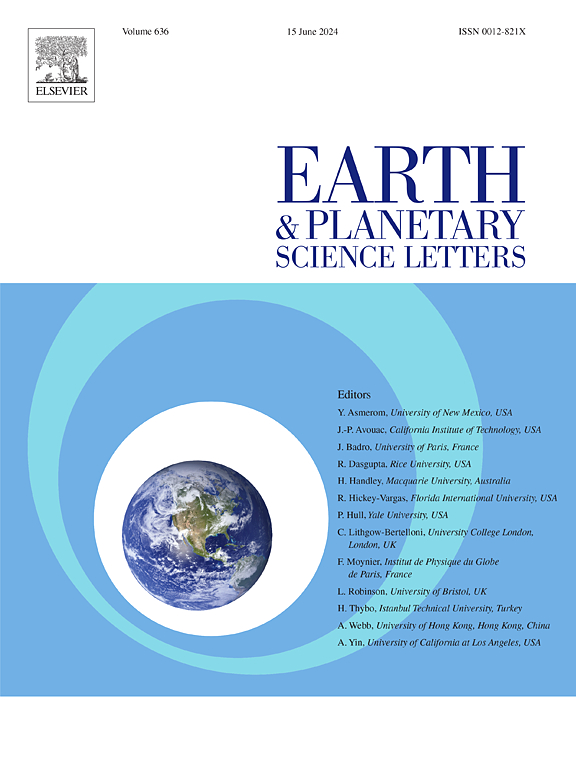b ølling- allero ød期间亚北极太平洋中部深度脱氧和碳储存增强
IF 4.8
1区 地球科学
Q1 GEOCHEMISTRY & GEOPHYSICS
引用次数: 0
摘要
重建海洋碳库的变化对于理解海洋如何调节大气二氧化碳(CO2)波动至关重要。人们认为,在b ø ling- allero ød (BA)期间,大量的二氧化碳从亚北极太平洋深处释放出来。然而,这与整个BA中大气二氧化碳上升的减缓或暂停是不一致的。在这个问题上,有人推测亚北极太平洋中深度的碳储量增加,需要更多的地质重建来证实这一点。本文利用亚北极太平洋西部中深度LV63-41-2岩心的磁化石和氧化还原敏感微量元素记录,重建了末次冰消期的古氧化还原条件和碳储量变化。BA期间,长形磁化石比例显著增加,自生U富集,与上覆底水和沉积物孔隙水氧浓度较低一致。这种BA脱氧在亚北极太平洋中深度地区广泛存在,可能反映了呼吸溶解无机碳储量的增加。此外,低氧沉积环境有利于更多的有机碳被埋藏在沉积物中。亚北极太平洋中部深处呼吸碳储量和有机碳埋藏的增加可能减缓了BA大气CO2的上升。本研究强调了磁化石在重建亚北极太平洋古氧化还原条件方面的重要应用价值,指出了亚北极太平洋中深层在调节大气CO2波动中的重要作用。本文章由计算机程序翻译,如有差异,请以英文原文为准。
Enhanced deoxygenation and carbon storage in the mid-depth subarctic Pacific during the Bølling-Allerød
Reconstructing changes in ocean carbon reservoir is essential for understanding how oceans regulate atmospheric carbon dioxide (CO2) fluctuations. It has been considered that large amounts of CO2 were released from the deep subarctic Pacific during the Bølling-Allerød (BA). However, this is inconsistent with the slowing or pausing of atmospheric CO2 rise throughout the BA. On this issue, an increase of carbon storage in the mid-depth subarctic Pacific is speculated, more geological reconstructions are needed to confirm it. Here, we present magnetofossils and redox-sensitive trace elements records from core LV63–41–2 retrieved from the mid-depth western subarctic Pacific to reconstruct the paleo-redox conditions and carbon storage changes spanning the last deglaciation. The significantly increased proportion of elongated magnetofossils and the enrichment of authigenic U are identified during the BA, consistently indicating lower oxygen concentration in the overlying bottom water and sediment pore water. This BA deoxygenation was widespread across mid-depth subarctic Pacific areas and could reflect increased respired dissolved inorganic carbon storage. Furthermore, the low-oxygen sedimentary environment would facilitate more organic carbon to be buried in sediments. The increases in respired carbon storage and organic carbon burial in the mid-depth subarctic Pacific might have slowed BA atmospheric CO2 rise. This study highlights the significant application value of magnetofossils in reconstructing paleo-redox conditions in the subarctic Pacific and points out the important role of the mid-depth subarctic Pacific in regulating atmospheric CO2 fluctuations.
求助全文
通过发布文献求助,成功后即可免费获取论文全文。
去求助
来源期刊

Earth and Planetary Science Letters
地学-地球化学与地球物理
CiteScore
10.30
自引率
5.70%
发文量
475
审稿时长
2.8 months
期刊介绍:
Earth and Planetary Science Letters (EPSL) is a leading journal for researchers across the entire Earth and planetary sciences community. It publishes concise, exciting, high-impact articles ("Letters") of broad interest. Its focus is on physical and chemical processes, the evolution and general properties of the Earth and planets - from their deep interiors to their atmospheres. EPSL also includes a Frontiers section, featuring invited high-profile synthesis articles by leading experts on timely topics to bring cutting-edge research to the wider community.
 求助内容:
求助内容: 应助结果提醒方式:
应助结果提醒方式:


